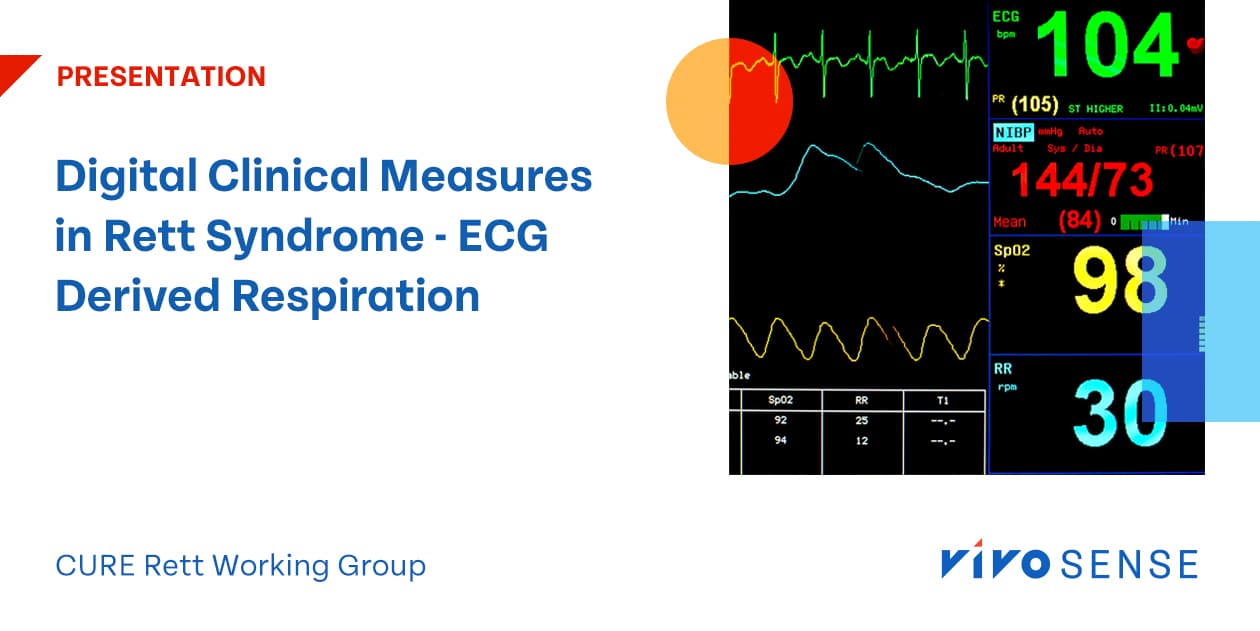In this video, Dudley Tabakin, VivoSense CEO, shares an example of how rare disease researchers can use wearable sensors to develop digital clinical measures to improve patient outcomes. He discusses our approach to developing outcome measures from ECG Derived Respiration (EDR) to discover novel respiratory endpoints for Rett Syndrome, working with Rett Syndrome Research Trust.
Edited Transcript
What are Digital Clinical Measures?
Digital clinical measures include outcomes measurable with a wearable sensor and collected as passively as possible, with little or no intervention; put on a device, and measure meaningful aspects of health in the real world.
Reasons to Develop Digital Clinical Measures
Novel Endpoints: Wearable sensors allow researchers to measure outcomes that haven’t been previously measured in the patient population, like wake apneas/ breath holds, leading to the discovery of novel endpoints which may be more sensitive to treatment effects.
Objective Measures: There’s also potential for objective endpoints to:
- • Replace some of the subjective patient report or caregiver report that is typically collected in rare disease populations.
- • Enhance that patient report data and provide more contextually rich endpoints.
Continuous data collection: Real-world and continuous data collection expand recruitment because the patient doesn’t need to come into the site. We can collect data at home, connect it continuously for long periods, and identify the timing of events, treatment effect, such as tachypnoea events and breath-holds in Rett Syndrome patients.
The Standard Approach
How to Measure: Polysomnography and Respiratory Plethysmography
Digital clinical measures derived from polysomnography have already been used in Rett Syndrome. Polysomnography is the gold standard for sleep measurements for identifying apnea, hypopnea, tachypnoea, Cheyne-Strokes breathing, and more. The data is collected using respiratory plethysmography (two bands – one around the chest and one around the abdomen), which measures the expansion and contraction of the chest and abdomen.
Data can also be collected when the patient is awake. Data collected during the day needs cleaning and more, but measurements from Respiratory Plethysmograph have been produced in Rett Syndrome clinical trials, both as exploratory and secondary endpoints.
What to Measure: Continuous Monitoring of Abnormal Breathing
Figure 1. Respiratory Plethysmography data in a Rett Syndrome patient [Click to Enlarge]
Figure 1 shows a screenshot of respiratory plethysmography data in a Rett Syndrome patient.
- 1. The top chart shows the tidal breathing volume with the minimum and maximum respiratory patterns.
- 2. The second chart shows the breakdown of the tidal breathing volume, a combination of the abdominal (green) and ribcage respiration bands (blue).
- 3. The third chart displays the respiratory rated shown in red.
- 4. The fourth chart charts the TT, total time for each breath, in green.
When data is combined into a single view and applying algorithms and machine learning, it is easy to observe the apneas and hypopneas derived from the respiratory plethysmography bands. This approach has been used in clinical trials successfully in the past.
The Novel Approach
How to Measure: ECG Wearable Sensor
Abnormal breathing or breath holds and tachypnoea can also be measured and identified by an ECG patch, a wearable sensor typically the size of a Band-Aid placed on the chest. So instead of using two respiratory bands, you can use this one sensor.
The goal is to identify respiratory abnormalities from ECG signals by looking at R wave to R wave interval timing. The R wave is the largest of three electrical stimuli that pass through the heart’s conduction system: the bigger the wave, the more electricity is going through the heart.
Artifact Management
Since measurements are collected while the patient is awake and performing real-world activities, data will be noisy. Conflicting beats from motion and sensor artifact data must be identified and managed so they don’t skew the study outcomes inappropriately.
Consider other factors that can impact data analysis, such as the patients’ age, respiratory rate, and range of respiratory rates for the patient population. For example, younger patients have a higher healthy respiratory rate than adults, and Rett Syndrome patients also have higher respiratory rates overall at any age.
Validation: Compare EDR Measurements to Capnometer
To validate our ideas about using EDR in a Rett Syndrome study, we did a small comparative study with a capnometer and MC10 ECG patches (Band-Aid size patches that can be placed on the chest). We looked at respiratory rates in different intervals: 30 seconds, 60 seconds, five minutes, and the entire measurement period of the capnometer, around 30 to 35 minutes in each recording.
Figure 2. Comparison of EDR Measurements to Capnometer [Click to Enlarge]
The data in Figure 2 shows a close match between the data collected from the ECG Derived Respiration (EDR) vs. the capnometer. The mean respiratory rate and breaths per minute was 19.7 for a 30-second EDR versus 21.4 for the capnometer. That shows that EDR is a reasonably good option for measuring respiratory rates to identify abnormal breathing patterns.
Figure 3. Comparison of EDR to Capnometer – 30-second trend [ Click to Enlarge]
The data in Figure 2 shows a close match between the data collected from the ECG Derived Respiration (EDR) vs. the capnometer. The mean respiratory rate was 19.7 breaths per minute for a 30-second EDR versus 21.4 for the capnometer. This shows that EDR is a reasonably good option for measuring respiratory rates to identify abnormal breathing patterns.
 Figure 4. Comparison of EDR to Capnometer – 60-second trend [ Click to Enlarge]
Figure 4. Comparison of EDR to Capnometer – 60-second trend [ Click to Enlarge]
The data from the 60-second trend (Figure 4.) is also aligned; increases in respiratory rate are as expected during the 6MWT and 2MWT. The five-minute trend (Figure 5.) also showed a good match between the two devices. There is a bigger standard deviation on the EDR (red) than the capnometer (blue) for the total duration. Overall, there is a good match between them once again.
 Figure 5. Comparison of EDR to Capnometer – 5-Minute trend [ Click to Enlarge]
Figure 5. Comparison of EDR to Capnometer – 5-Minute trend [ Click to Enlarge]
What to Measure: Using EDR in Rett Syndrome Abnormal Breathing
With this validation in hand, we wanted to design the best approach for measuring abnormal breathing in Rett Syndrome patients. Our strategy for a novel respiratory endpoint included EDR because:
- 1. It’s less intrusive. Respiratory plethysmography requires two bands that have to be relatively tight around the chest and abdomen. Typically, it’s a worn vest (Hexoskin) that can be uncomfortable to wear, especially for females. A wearable sensor patch is much easier to continuously wear because it can stay on comfortably for 14 days.
- 2. Validation: We studied and determined that EDR measures respiratory rate with similar accuracy to capnometers. In addition, respiratory plethysmography has also been compared to capnometers and has a good correlation. We can compare EDR measures to those derived by Respiratory Plethysmography to further validate the measures in the real world.
- 3. It can measure something new. There is potential to detect apneas, tachypnoea (increased respiratory rate), or breath-holding during wake periods using only an ECG patch.
We’re working with Rett Syndrome Research Trust on the Emerald study, where they’re collecting ECG from MC10 bio stamps on up to 20 Rett Syndrome patients. We have an in-clinic measure of respiration with respiratory plethysmography simultaneously that we use as ground truth in these data. In the first part of the study, we compare the respiratory plethysmography to the ECG Derived Respiration (EDR) and look specifically at apneas and respiratory rate.
Data Example: Apnea Identification with EDR
 Figure 6. Apnea Identification with EDR [ Click to Enlarge]
Figure 6. Apnea Identification with EDR [ Click to Enlarge]
- 1. First Chart (Green): The tidal breathing volume from respiratory plethysmography. Some apneas and breath holds are occurring.
- 2. Second Chart (Red): The red shows the heart rate derived from the ECG channel.
- 3. Third Chart (Blue): The ECG Derived Respiration (EDR) is equivalent to the tidal breathing volume in the first chart, but it’s derived from ECG. The peaks are shown in yellow and red, and they identify individual breaths.
- 4. Fourth Chart (Blue and Green): This chart shows the Time of Inspiration (TI) for each breath. The TI of the ECG Derived Respiration matches very well with the TI increase as measured by respiratory plethysmography.
These Time of Inspiration EDR are events identified with algorithms and some machine learning and are used to discover apneas or breath holds on inspiration from the EDR. We are matching this to the respiratory plethysmography, and the results are very promising.
A closer look: The yellow in Figure 7. denotes apnea from the respiratory plethysmography. We can see it’s overlaying almost exactly with what we identify from the EDR. So far, the data shows promising results for us to identify apneas from ECG patches.
 Figure 7. Apnea Identification with EDR [ Click to Enlarge]
Figure 7. Apnea Identification with EDR [ Click to Enlarge]
Advantages of Digital Outcome Measures in Rare Disease Research
We’re having many conversations with sponsors, with the support of Rett Syndrome Research Trust (which we appreciate!), to advance opportunities to use digital outcome measures and provide novel outcome measures from wearable sensors in clinical trials. EDR is an example of these real-world measures.
Wearable sensors can continuously monitor patients for days, weeks, and months. With the right sensor, fit-for-purpose application, and novel outcome measures, researchers can address meaningful aspects of health for the patient and caregiver, leading to new and meaningful primary endpoints in clinical trials.
Dudley Tabakin
Dudley Tabakin, MSc. is Chief Executive Officer and co-founder of VivoSense and a fervent believer in “good data” over “big data” in the development of digital endpoints from wearable sensor technology.

